Growing the Community
The Plaza Cinema (Kinema)
The Sykes decided to build the cinema in 1926. This decision was vigorously opposed by the company secretary who pointed the difficulties in making it viable when there were 7 other cinemas close by. Nevertheless, the cinema opened on 19 Jun 1928 and operated until the end of 1940. It seated 566 (with a capacity for a later gallery/balcony to seat a further 300).
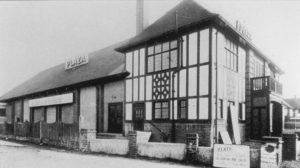
It was provided with a sizeable stage 35 feet wide and 23 feet 6 inches deep and dressing rooms on either side. There was an ample foyer and proper toilet facilities as well as the usual offices on the ground floor and a good staircase leading to a café with a properly equipped kitchen on the first floor.
Later in the summer of 1928 the instillation of a Compton Organ was completed, on a lift from a pit, at a cost of some £3000. The total cost of the Plaza was put at not less than £15,000 in the 1928 Company Prospectus, and it was described in detail in the Report and Valuation document. It was to be under the management of Mr K. A. van Biene, son of the cellist of The Broken Melody fame.
The cinema was never profitable. Mr Roberts was of the view that part of its purpose was publicity and status: a very smart model was prominently displayed in front of a diorama in the company’s office in Regent Street. It was designed by Clare and its mock Tudor facade and high pitched roof reflected the facing parade of shops. It provided an excellent venue for The Richings Players and the Richings Choral Society, both ‘original’ organisations and still active today.
After the collapse of the company in 1931 it and its car park (land originally reserved for an hotel) were sold to 2 private owners who each took out mortgages and then a property company who all continued to run it as a cinema. When it finally closed in 1940 it was bought by Mr Norrish who let it to Taylors (also of Chiswick) and it became a warehouse for bombed-out furniture from London.
Strenuous efforts were made, post war, to acquire it as a community centre. However, Mr Norrish and his agents were very demanding and he let it again as a warehouse to McMichael Radio of Slough, who were taken over by Sobell Radio and then GEC. Eventually he sold it in 1959 and it was demolished to make way for Wellesley Court which was completed in 1963.
The proposed Community Centre
At the end of the war the sense of relief and thankfulness generated a high level of community spirit and it was proposed to create a community centre as a memorial for the future.
There were halls attached to the churches and the Tower Arms but these were not really adequate. So a Committee was set up with Mr Crowther (senior) as its Treasurer, which set about fund raising.
The cinema was seen as a possible starting point as it had good facilities and could provide for a range of activities. The furniture it had housed during the war had been returned to its owners and it was empty.
The Richings Players were keen to perform there again, but Mr Norrish, the owner, was not amenable. The idea of the Community centre was kept alive by a proposal by Bucks Education Committee to build a first school in Richings Park.
The necessary facilities which should be added to the school for a community centre were discussed and a site at the western end of Bathurst Walk (before the present houses were built) was considered. However, a similar facility was finally built in Iver instead. The fund was wound up and the money subscribed was returned, although some suggested that other commemorative purposes should be found for it.
The Recreation Ground/Sports Club
Magazine article by Alan J Seal suggests that a school was originally planned for where the sports club is now but there has been no mention of this elsewhere.

The configuration of the lay-out of the streets resulted in a large triangular area in the middle being left vacant. The sacrifice of only one house in each of the three surrounding streets could have given
adequate entry to many more than three houses on this 9 acre site but from the beginning it was designated as a recreation ground. The Sports Club was one of the ‘original organisations’ and remains still active. Other later plans showed an intention to provide further tennis courts but these did not materialise.
Residents’ Association Resident’s Garden
This corner had been intended in 1928 as a site for Barclays Bank which was never built because Richings Park did not grow as expected and a sub-branch at 32 Bathurst Walk (now the café), as a tenancy, had proved adequate. In 1979 the bank gifted the land to the Richings Park Residents’ Association and a not-for-profit trust was set up to take ownership with 2 trustees. These are currently Mark Wynn and Nicholas Jones.
The plot is larger than at first appears; the hedge bordering the garden merely represents the building line for the bank Barclays originally intended. It is 45ft. frontage to Bathurst Walk and 70ft. return on Wellesley Avenue and brass studs in the brick paving define the precise boundary.
Townswomen’s Guild
The Guild in this country and overseas had their roots in the Kensington Ladies Discussion Group formed by radical thinkings women in 1865. When the Universal Franchise was granted in 1928, the Suffragist Party (not the militant suffragettes) felt that there was a need for an organisation for women living in towns and cities which would help them manage their new-found freedom.
The Richings Park Townswomen’s Guild was one of the first Guilds to be established in the country and the oldest in the Bucks, Berks and Oxford Federation, now the Chiltern and Castle Federation. There are about 90,000 members in 2000 autonomous Guilds divided into 115 Federations.
This is our 70th year which will be marked by a Federation with the National chairman presiding. Guilds are mandated by an annual National Council meeting, usually held at the Albert Hall, where campaigns on issues of national and international importance are discussed and the conclusions are brought to the attention of the Government. Membership is open to everyone regardless of politics, religion, race or circumstances.
All activities are covered – sport in all its forms, drama, recreational activities, including craft classes, plus keep fit and painting classes. Richings Park has taken full part in these activities with diverse classes under Bucks County Council and the British Drama League.
The latter provided a Cup for the Federation Drama section inaugurated by a Richings Park Chairman who was also Federation Drama Chairman – Maidenhead Town hall was booked for a week and a half (including rehearsals) for the 15 Guilds competing for the Cup, which was won by Richings Park on many occasions.
There is a speaker at each meeting, two Guild lunches each year, a Christmas Party. Visits to Stately homes twice a year, and Sales tables at each meeting for Guild funds etc.
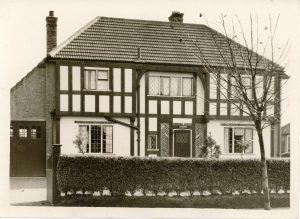
In the early days, four coach loads of ‘poor ladies’ from the East End of London were entertained for a day and Members’ gardens were on display – despite all the weeding that entailed.
There were also visits to interesting places – providing a tea was included – we got sick at Cadburys, eating the samples, we passed out in the dark room at Kodak’s, we went to plays, particularly Stratford where there was a supper stop at Banbury, and hence a late return, we put up with the dreadful smell of rotting Mulberry leaves, the staple diet of silkworms, at the Lullingstone Castle silk factory, and came home deafened by the noise at the Mint.
These early days were marked by ‘proper’ teas with cakes, sandwiches etc., floppy hats, gloves and scarves, scattered in all directions when we were taught Country dancing, we ‘Stripped the Willow’ danced the ‘Circassion Circle’ and ‘Gathered Peascods’ – hats, shoes and gloves everywhere, an experience not repeated!
We now have a smaller but equally happy Guild, at one time we had 250 Members; in 1932 the yearly subscription was two shillings – the yearly rate is now £11.00. [Kay Eames Chairman]
Richings Park Schools
There were three schools:
THE LIMES was a pre prep school for both boys and girls. Begun in Iver by Miss Bright, the school moved to Shires End in Richings Park and changed its name at some time not known. When still located in Iver, first in a private house and then in the Church Institute, the pupils from Richings Park walked in a crocodile the mile to Iver village lead by Miss Bright’s assistant, Mabel Naesmith.
Miss Mary Martin from 1 Bathurst Walk could recall the walk in their uniforms everyday. School was in the mornings only and the uniform for boys was a brown cap with an LS monogram in a shield on the badge.
Shires End, as it was later called (now demolished), had been the laundry for the mansion in the park. It stands up its own drive off North Park, opposite to Main Drive. There was a large wooden school hut in the yard behind the wash house and a lady from one of the cottages came in to cook the lunches.
The Limes is thought to have been the first school in Richings Park and in 1937 it moved to a house purpose-built in St Leonard’s Walk for Miss M E Kidwell, a teacher at the school. Miss Bright then sold to Miss Kidwell and retired; although the school continued under Miss Bright’s established name. It then became Boys pre-prep and Girls prep called LINTON HOUSE and she had as many as 50 children well in hand.
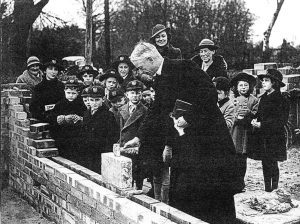
Mick Crowther can just remember a demure Miss Kidwell playing the organ in St Leonard’s Church when he was a choir boy. Miss Bright retired to her flat in London, where she was killed in the Blitz. Linton House school continued until the death of Miss Kidwell.
WESTFIELD HOUSE – this was a pre-prep school for boys and girls at what is now 9 North Park, run by a Miss Overton. She was already in business by around 1930. Mick Crowther can dimly remember her “calling at our house when he could only have been 3 or 4, to suggest that his mother might appreciate being free from him for part of the day’. Hardly the argument used now in favour of infant schooling! She did not gain another pupil.
Of all the schools, Miss Overton’s Westfield House survived the longest. She retained ownership of the building long after her retirement.
Following this, it is not known who ran the school for the next few years. This period was followed by a 12 year tenure by Miss Molly Knight. She saw the school into the 1960s.
Her successors were in charge for another 10 or so years until closure sometime around 1973. The building was then purchased by Mr and Mrs Miles and converted back into a private house. At some time during the post WWII period, the school became known as PARK CLOSE. It had become the pre-prep for Long Close School in Slough.
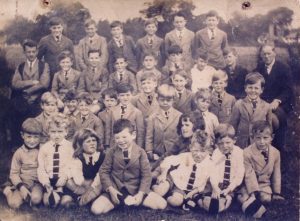
Long Close still thrives but economics dictated the closure of Park Close. The pre-prep facility was lost until Long Close re-established its own pre-prep around 1974. Miss Overton’s school had in total enjoyed a career of some 45 years – a fine achievement in changing times and changing social circumstances.
RICHINGS PARK SCHOOL FOR BOYS – Preparatory. This, along with the Limes, was set up at the beginning, being advertised in the original Frank, Knight and Rutley brochure for the estate as Abingdon School, principle Mr O.G. Furnivall, formerly Senior Assistant Master of Lewes Grammar School . By 1928 it had become Richings Park School and was located in Percy Lodge (39 Old Slade Lane – next to the farm) which has had various names since then. Mr Donald King, former Richings Park Estate Agent among others began his education there. Initially, some boys remained at the school until the age of 15 when they left to take up apprenticeships or other training.
This school was run by Captain Humphrey Fenn who was succeeded by Mr Kenneth B. Bachelor, with Mr William O. Betts (known as Wob) as an assistant and Mrs Boswell as a helper whose two daughters Rosemary and Margaret attended the school. They were the only girls among some 30 boys!
The school was a going concern when it transferred to the occupancy of the right wing of Miss Overton’s Westfield House in about 1932-3
Mr Betts was then in charge. He was ably supported by his sister, with a series of local assistants. They ran a meticulously careful preparatory school from which boys passed successfully at 11+ to Slough Grammar school, or, at 13+, to several other well respected schools.
In early 1938, the school moved to Shires End following Miss Bright moving with Miss Kidwell to the new Linton House. It was a modest establishment with approximately 30 pupils. There had been plans that the school would expand into Richings Lodge but these failed. The school continued into the war but had gone by the end in 1945.
Mick Crowther recalls “I joined the school aged 6 in 1935. Also at the school, two years ahead of me, was Mr George Simmons resident at Shires End for some 30 or more years. I left at the end of summer 1939 to go to Slough Grammar. Here were already Donald Fletcher -from the cycle shop in Thorney Lane South and Rex Bishop – from 15 Bathurst Walk (I think). They were in the Scout Troop when I was. Four others of my contemporaries also went to Slough Grammar – others ended up in Haileybury, Merchant Taylors, and Northwood.
“There was very careful attention to accurate self-expression both orally and in writing. I can’t remember French but I had already done the first year in Latin, when I arrived in Slough. Basic books on History and Literature had been studied. BBC Sports programmes on the wireless were regularly taken. There were school visits – I went twice to dress rehearsals of the Aldershot Tattoo – a ‘Tizer and Crisps’ trip. We visited Britannic Cable on what is now the Ridgeway Estate and the Uxbridge Flint Brick factory in Cowley, then with its original name – Hunziker (it was then Cape Boards and now a car sales yard). I remember a rather wet afternoon at a matinee at Regents Park Open Air Theatre. Games, however were sketchy – but maintained.”
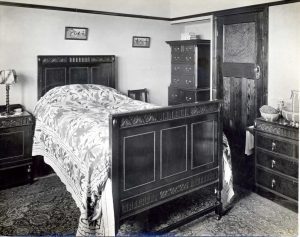
These schools variously prepared children for:
- Halidon House school (for girls) in the now extinguished Mackenzie Street in Slough (former approach to Slough Station). It then moved to Fulmer and is now defunct.
- Uxbridge High School, later Frays College.
- The County Secondary School in the former William Street in Slough (also disappeared following modern road changes in Slough – roughly where Slough College now stands).
- St Bernard’s Convent in Langley at that time for girls only.
- Tower House in Slough
- Windsor House in Slough? Windsor?
From 1937 and 1938, the Boys Grammar School and the Girls High School in Slough respectively, took pupils from Richings Park schools.
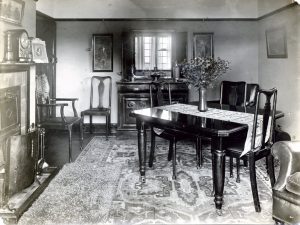
The preparatory (13+) function for boys continued for a time for senior schools such as Abingdon, Haileybury and Aldenham.
The Shops
Those in Thorney Lane, on the east side of the road, were built in 1926 by Lowdells Ltd on Tower land (Huntsmoor Estate) and were a private speculation. The architect was a Mr Robins and they bore no relationship at all to the Richings Park Company.
To begin with, mobile shops came in from Iver Village and West Drayton to supply the first residents of Richings Park, but the provision of shops was an integral part of the Sykes’ perception of what they were creating. George Clare shared this vision and took very considerable care to create several parades of distinction.
The design deliberately set out to create an approach of great style from the railway station to this unique garden development with the eye being drawn past the imposing gables of the shops to the dignity of the tree lined Wellesley Avenue and the spacious circular junction with Somerset Way. The parade of shops on Bathurst Walk (Wellesley Avenue to Bathurst Close) was never completed nor was the southward extension, on a narrower profile, of the parade on Upper Wellesley Avenue.
Early among the shops was The Dairy at No. 9, Wellesley Avenue (now the Post Office) and the bottling plant next door in a purpose-designed building by Clare with a louvre-ventilated roof-ridge. The Sykes had retained and operated Home Farm on the Estate which continued primarily as a dairy farm.
Eric Sykes, the youngest brother, was the manager. There was a dairyman and staff and the original promotional materials for the Company made play of deliveries of fresh milk twice daily from the pedigree Friesian herd and model dairy under ‘superlative conditions’.
Initially Mr Reeves, the farm manager, undertook the milk round. On 25th March 1929 the commercial site of the Dairy was sold to Mr J.S. Anthony. He and his family became residents of long-standing and his daughter married Mr Whitby Roberts. Mr Anthony managed the Home Farm for the receiver and eventually sold his dairy interest to United Dairies. The bottling plant became Richings Motors in about 1936.
The Estate office was originally in the small corner shop between the dairy and the bakery and had its petrol pump outside. After 1928 the office moved to the bungalow at 1 Syke Ings. The estate agent Mr Alfred King was appointed, having previously been a property manager near the Company’s Regent St office.
He occupied the end premises by the railway, now the home of a finance company. He was succeeded by his son Donald King. Many remember the illuminated sign high on the side of the building visible from the railway.
The row of shops along Bathurst Walk towards Thorney Lane was never completed and the fireplaces and flues intended to be incorporated into a further building can still be seen. Similar remnant fireplaces can be seen on the end of the parade of shops by Buckfield Court, although it is not clear what was intended to stand here as the adjacent plot was early on sold to Barclays bank.
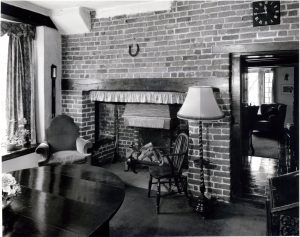
Churches
St Leonard’s Church has strong links to the Richings estate. The building, originally called Thorney Chapel, dates from 1839/40 and was probably given by Mr Sullivan of Richings Lodge to serve as a school or small chapel, licensed for worship for workers on the estate and nearby farms.
In 1874 the building was reopened, enlarged and renovated by Mrs Charlotte Meeking of Richings Lodge in memory of her husband Charles. A chancel was added and the porch moved from the east end to the west end.
When Mrs Meeking died in 1889, the building was closed by her son Col Charles Meeking and not reopened until 1910. When Miss Meeking (later Lady Apsley) sold the estate to the Sykes brothers in 1922 she made it clear that the land on which Thorney Chapel stood was not included in the sale.
As a result of the Richings Park development, the chapel (a daughter church to St Peter’s Iver) was found to be too small for the influx of families and in 1930 an appeal was launched for funds to enlarge ‘The Chapel of Ease on the Richings Estate’.
On 15th June 1931 the foundation stone for the extension of Thorney Chapel was laid by Mrs Lewis Hall (formerly Meeking). The plaque can still be seen in the west wall.
A new west end bay, vestry and porch were added. After this enlargement it became known as Thorney Church. An adjacent Hall was built in 1933. This was due to be opened by Princess Victoria of Coppins, Iver, but as she was unwell it was opened by her lady-in-waiting Lady Blanche Seymour of Iver Lodge.
In 1942 it was rededicated to preserve the local memory of St Leonard who is variously the patron saint of prisoners, women in labour and horses! This change of name made a link with the Richings estate as, according to Lady Hertford in 1740, there had been a chapel dedicated to St Leonard, on the site where her greenhouse stood.
Cloakrooms were provided in an extension to the Hall in 1938 and in 1968 a kitchen was added. In 1960 a new choir vestry was added and St Leonard’s house, behind the Church, was built for Iver’s curate and his family.
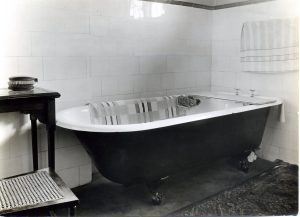
Who was St. Leonard? He was a French nobleman (c485-559 AD), hermit and monk who devoted his life to the care of prisoners. The Norman invasion brought his fame to England and he was a popular saint in the Middle Ages. His day in the Christian calendar is 6 November.
He was a godson of King Clovis I of the Franks and after he became a monk near Orleans, he later retired to a forest as a hermit. Here he was able by his prayers to help the safe delivery of a child to King Clovis’s Queen who had begun to be in labour while out with a hunting party.
As a reward the King gave him lands – as much as he could ride around in one night on a donkey – on which he founded a monastery where he became Abbott for the rest of his life.
St Leonard is renowned for the help he gave to prisoners, by his prayers, pleas on their behalf and by raising money to pay their ransoms. This explains why he is the patron saint of prisoners and women in labour.
The Congregational Church
Now St Andrews’ United Reform church, this was started in 1928 and used the Plaza for services initially. The present building opened in 1931.
For more information about the local churches see the book by Stella Rowlands available at Cornerstone.